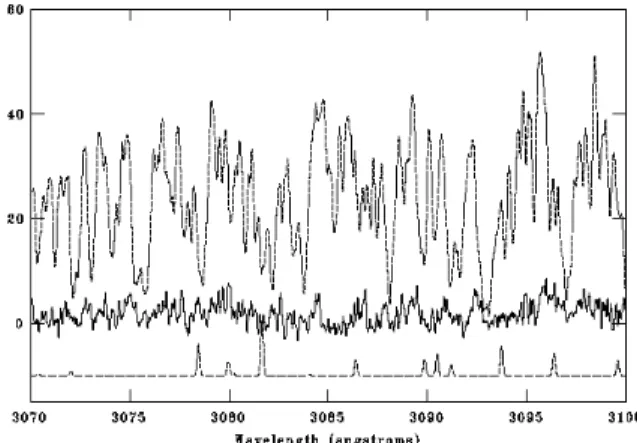A SEARCH FOR ESCAPING WATER FROM CERES' POLES*. P. Rousselot1, O. Mousis1, C. Dumas2, E. Jehin3, J. Manfroid3, B. Carry2 and J.-M. Zucconi1, 1University of Franche-Comté, Observatoire de Besançon, Institut UTINAM–UMR CNRS 6213, BP 1615, 25010 Besançon Cedex, France (email: rousselot@obs-besancon.fr), 2European Southern Observatory, Alonso de Cordova 3107, Vitacura, Casilla 19001, Santiago 19 Chile, 3Institut d'Astrophysique et de Géophysique, Université de Liège, Allée du six août 17, B-4000 Liège, Belgium.
The dwarf-planet (IAU 2006) Ceres, whose mass represents 30 to 40% of the Main Belt, was discovered in 1801 by the Italian astronomer Giuseppe Piazzi. Ceres possesses several intriguing physical character-istics. Among them, a mean density estimated to be near 2.1 g.cm-3, suggests that the shape of Ceres is the result of a rocky core surrounded by an ice-rich mantle [1][2].
A large number of multi-wavelengths observations of Ceres' surface have been carried out in the past years in order to investigate the presence of ices. Thus, some near infrared spectra have been found compatible with the presence of water ice in some regions of Ceres' sur-face [3][4][5].
Moreover, long-exposure IUE spectra of the region around the limbs of Ceres have been conducted by A'Hearn & Feldman [6] to explore the possibility that OH resulting from the photodissociation of atmospher-ic water vapor might escape. They reported the detec-tion of OH above the northern limb of Ceres after peri-helion while no evidence of this radical has been found off the southern hemisphere before perihelion.
High resolution spectra were acquired with the Ultravi-olet and Visual Echelle Spectrograph (UVES) of the ESO VLT under very good seeing, low airmass (~1.3) and photometric weather (see Table 1 for the observing circumstances). The slit was placed within a few arc-seconds off both Ceres' poles to search for the 309 nm OH emission lines which would reveal water escaping from the dwarf planet.
After data reduction with the UVES ESO pipeline and the subtraction of a solar spectrum in order to re-move the contamination from sunlight reflected by Ceres within the slit no OH emission line is detected on both northern or southern poles (see Fig. 1).
We will present our observations which permit to derive an upper limit for the OH quantity along the line of sight, as well as for the water production rate of Ceres. Because our observations were conducted with a combination telescope+instrument more sensitive than IUE they contradict the positive detection published by A'Hearn & Feldman. We will discuss the possible reas-ons for this contradictory result.
* Observations collected at Paranal Observatory under ESO programme 080.C-0881(B)
Figure 1. Spectrum of the northern limb of Ceres ob-tained with UVES on December 5, 2007. Intensity is given in arbitrary units. Dashed line: spectrum before solar continuum subtraction. Solid line: final spectrum after solar continuum subtraction. The synthetic OH emission lines are represented below the final spectrum for more clarity. These lines are not detected.
UT start R ∆ limb
2007 Oct. 24, 04:40 2.83 1.88 South
2007 Oct. 24, 05:40 2.83 1.88 North
2007, Dec. 5, 01:40 2,79 1,91 North
2007, Dec. 20, 00:40 2,78 2,03 North
Table 1. Observing circumstances (R: heliocentric dis-tance (AU); Δ: geocentric disdis-tance (AU)). The expos-ure time was 2850 s for each spectrum.
References:
[1] Thomas, P. C. et al. (2005) Nature, 437, 224 [2] McCord, T. B. and Sotin C. (2005) JGR, 110, 5009 [3]Lebofsky, L. A. et al. (1981) Icarus, 48, 453 [4]Vernazza P. et al. (2005) A&A, 436, 1113 [5] Carry, B. et al. (2008) A&A, 478, 235
[6] A'Hearn, M. F. and Feldman, P. D. (1992) Icarus, 98, 54
